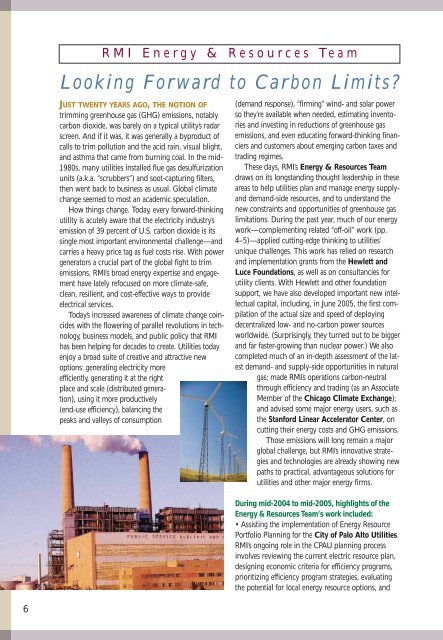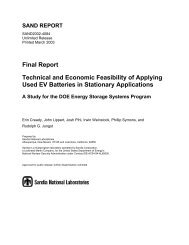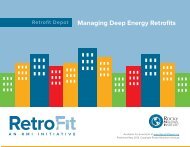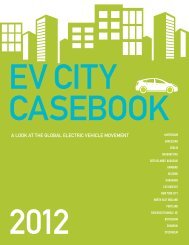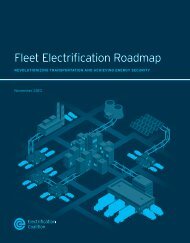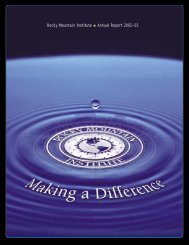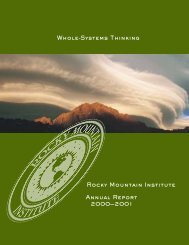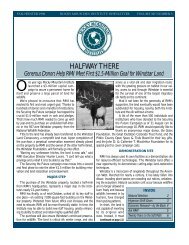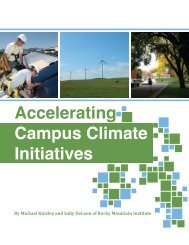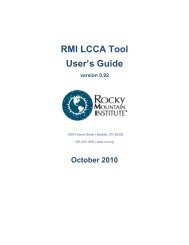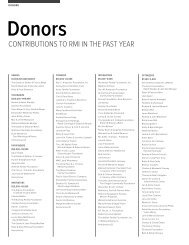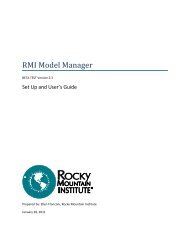Abundance by Design - Rocky Mountain Institute
Abundance by Design - Rocky Mountain Institute
Abundance by Design - Rocky Mountain Institute
- No tags were found...
You also want an ePaper? Increase the reach of your titles
YUMPU automatically turns print PDFs into web optimized ePapers that Google loves.
RMI Energy & Resources TeamLooking Forward to Carbon Limits?JUST TWENTY YEARS AGO, THE NOTION OFtrimming greenhouse gas (GHG) emissions, notablycarbon dioxide, was barely on a typical utility’s radarscreen. And if it was, it was generally a <strong>by</strong>product ofcalls to trim pollution and the acid rain, visual blight,and asthma that came from burning coal. In the mid-1980s, many utilities installed flue gas desulfurizationunits (a.k.a. “scrubbers”) and soot-capturing filters,then went back to business as usual. Global climatechange seemed to most an academic speculation.How things change. Today, every forward-thinkingutility is acutely aware that the electricity industry’semission of 39 percent of U.S. carbon dioxide is itssingle most important environmental challenge—andcarries a heavy price tag as fuel costs rise. With powergenerators a crucial part of the global fight to trimemissions, RMI’s broad energy expertise and engagementhave lately refocused on more climate-safe,clean, resilient, and cost-effective ways to provideelectrical services.Today’s increased awareness of climate change coincideswith the flowering of parallel revolutions in technology,business models, and public policy that RMIhas been helping for decades to create. Utilities todayenjoy a broad suite of creative and attractive newoptions: generating electricity moreefficiently, generating it at the rightplace and scale (distributed generation),using it more productively(end-use efficiency), balancing thepeaks and valleys of consumption(demand response), “firming” wind- and solar powerso they’re available when needed, estimating inventoriesand investing in reductions of greenhouse gasemissions, and even educating forward-thinking financiersand customers about emerging carbon taxes andtrading regimes.These days, RMI’s Energy & Resources Teamdraws on its longstanding thought leadership in theseareas to help utilities plan and manage energy supplyanddemand-side resources, and to understand thenew constraints and opportunities of greenhouse gaslimitations. During the past year, much of our energywork—complementing related “off-oil” work (pp.4–5)—applied cutting-edge thinking to utilities’unique challenges. This work has relied on researchand implementation grants from the Hewlett andLuce Foundations, as well as on consultancies forutility clients. With Hewlett and other foundationsupport, we have also developed important new intellectualcapital, including, in June 2005, the first compilationof the actual size and speed of deployingdecentralized low- and no-carbon power sourcesworldwide. (Surprisingly, they turned out to be biggerand far faster-growing than nuclear power.) We alsocompleted much of an in-depth assessment of the latestdemand- and supply-side opportunities in naturalgas; made RMI’s operations carbon-neutralthrough efficiency and trading (as an AssociateMember of the Chicago Climate Exchange);and advised some major energy users, such asthe Stanford Linear Accelerator Center, oncutting their energy costs and GHG emissions.Those emissions will long remain a majorglobal challenge, but RMI’s innovative strategiesand technologies are already showing newpaths to practical, advantageous solutions forutilities and other major energy firms.During mid-2004 to mid-2005, highlights of theEnergy & Resources Team’s work included:• Assisting the implementation of Energy ResourcePortfolio Planning for the City of Palo Alto Utilities.RMI’s ongoing role in the CPAU planning processinvolves reviewing the current electric resource plan,designing economic criteria for efficiency programs,prioritizing efficiency program strategies, evaluatingthe potential for local energy resource options, and6


